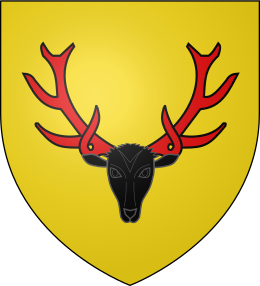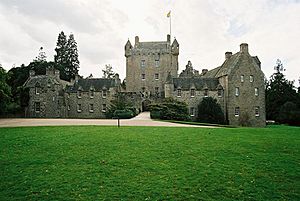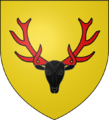Clan Calder facts for kids
Quick facts for kids Clan Calder |
|||
|---|---|---|---|
| Motto | Be Mindful | ||
| Profile | |||
| Region | Scottish Highlands | ||
| District | Inverness | ||
 |
|||
| Clan Calder has no chief, and is an armigerous clan | |||
| Historic seat | Cawdor Castle | ||
|
|||
|
|||
|
|||
|
|||
Clan Calder is a Highland Scottish clan. A clan is like a large family group, often with a shared history and a chief. The Clan Calder is officially recognized by the Lord Lyon King of Arms, who is the expert on Scottish clans. However, this clan does not currently have an official leader or "clan chief." Because of this, it is called an armigerous clan, which means they have a coat of arms but no current chief.
Contents
History of Clan Calder
Where the Name Calder Comes From
The name 'Calder' likely comes from an old language called Common Brittonic. It probably means 'hard water' or 'stony river'. You can find this name in many places across Scotland. For example, there are towns called East Calder and West Calder near Edinburgh. There is also a place called Calderwood near Glasgow.
A historian named William Anderson believed the name became important in Scotland because of a French knight. This knight, Hugo de Cadella, was given the title of Thane of Calder. A Thane was a powerful local lord. The Calders became very important nobles around Inverness starting in the 1300s. Sadly, an early Thane of Cawdor was killed by Sir Alexander Rait from nearby Rait Castle.
The 1400s and 1500s
The main tower of Cawdor Castle was built by the Calder family around 1454. This castle became their main home. The Calders often married into other strong local families, like the chiefs of Clan Rose.
However, the Calder family's direct line of chiefs ended in a dramatic way. A young girl named Muriel Calder was the last heir. Archibald Campbell, 2nd Earl of Argyll, a powerful chief of Clan Campbell, was made her guardian. He wanted to take Muriel to Inveraray Castle to raise her as part of his own family. Muriel's uncles, Alexander and Hugh Calder, tried to stop this. They chased Muriel and her Campbell escorts. Muriel was safely taken to Inveraray, but there was a lot of fighting. The Campbell leader, Campbell of Inverliver, lost all six of his sons in the chase.
Muriel was the last direct heir of the Calder chiefs. She grew up as a Campbell and later married Sir John Campbell, the Earl of Argyll's son. Muriel passed away around 1575. Her descendant, John Campbell of Cawdor, later became a lord in 1796. His son became the first Earl Cawdor in 1827. Today, the current Earl Cawdor still lives in Cawdor Castle, which was once the home of his Calder ancestors.
Even though the main line of chiefs changed, the Calder name continued. A branch of the family, the Calders of Asswanly, received land near Elgin in 1440. In 1686, this family was given a special title called a baronetcy of Nova Scotia. A very famous member of this family was Robert Calder, who served bravely in the Napoleonic Wars.
Modern Times
During World War II, Sir James Calder was an important advisor to the government's Ministry of Supply. Today, you can still find many Calders living around Inverness. For example, Douglas Calder was the President of the Royal Incorporation of Architects in Scotland. He also became the director of planning for the Highland Region in 1974.
Castles of the Clan Calder

- Cawdor Castle: This famous castle is about five miles southwest of Nairn. The Calders built much of the castle we see today. It has a large, four-story tower from the 1300s and a courtyard with other buildings. You reach the castle by crossing a drawbridge over a ditch.
- Nairn Castle: This castle dates back to the 1100s and was built by William the Lion. The Calders, as Thanes of Cawdor, were the keepers of this castle. It is also a traditional place where King Duncan was said to have been killed by Macbeth.
- Asloun Castle: Located two miles southwest of Alford, Aberdeenshire, this was a Z-plan tower house from the 1500s. Not much of it remains today. The Calders owned it before it passed to the Clan Forbes.
- Aswanley House: This house is seven miles west of Huntly. The Calders owned it from 1440 until 1768, when they sold it to the Duffs of Braco because of debts.
Images for kids
See also


